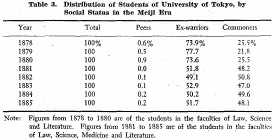| Home > Policy > White Paper, Notice, Announcement > White Paper > JAPAN'S GROWTH AND EDUCATION 1963 > CHAPTER |
||
In the ear1y stage of modernization, when the spread of education was yet limited the role played by the leaders in accelerating the modernization was essentially total. Before the introduction of the modern system, higher education was no more than the training of leaders from the families in the upper stratum of the feudal society. After the promulgation of the Government Order of Education in 1872, however, higher, education was opened to all the people regardless of their social status, taking account only of their potential ability as future leaders of the country. This policy contributed much to the extensive development of men of talent.
The institutions for higher education in the Meiji Era were the Imperial universities, colleges and higher normal schools.
In 1869 the Government unified into a single university the Coheir(university established by the Shogunate Government), Kaiseijo (institute of Western learning) and Igakusho (institute of Western medicine) which it inherited from the feudal government of the Shogun (17th-19th century). Later, in 1877, this became the University of Tokyo, and, in 1886, the Tokyo Imperial University which remained the single multi-faculty university and institution for the training of national leaders in Japan until 1897.
From the days of the Kaiseijo and the Igakusho the major courses of leader-training had been the Western learning and medicine. But in 1877 when the University of Tokyo was founded, the Faculty of Law was opened in addition to the former faculties of Medicine, Science and Literature, and the training of modern administrators was begun. In 1886 the Faculty of Engineering was added to the University and in 1890 the Faculty of Agriculture. The sequence of the establishment of these faculties-Medicine, Science, Law, Engineering and Agriculture-is indicative of the sequence of recognition of the need for developing leadership for the socio-economic modernization of the country.
Some consideration should be given to the spread of higher education in the early Meiji Era from the viewpoint of the social status of the students.
The class-division of samurai (warriors), farmers, artisans and tradesmen was abolished in education by the promulgation of the Government Order of Education in 1872, and all the people were given equal opportunity for education. Further, opportunities to advance to schools of higher level were given to all those who had completed elementary education. The social status of the students in the University of Tokyo from 1878 to 1885 is shown by year in Table 3.

The ratio of the number of students from the ex-samurai class to that of those from the commoners' class was 3 to l in 1878, but was reduced to approximately l to l for beginning in 1881. An estimation based on the census taken in 1874 shows that the ex-samurai class represented only 5.6 per cent of the total population. It is obvious that the children of the samurai class had greater opportunity for education that those of the commoners' class.
This does not mean, however, that the former were more capable than the latter. Rather, the ex-samurai were more interested in educating their children than the commoners and were better able to do so.
In any case, it is noteworthy that from 1881 to 1885 approximately onehalf of the total enrollment at the University of Tokyo, the 'privileged' institution of the time, were from the commoners' class.
In this way the spirit clearly set forth in the Government Order of Education of 1872 was materializing not only in elementary and secondary education, but also in higher education.
| Back to Top | MEXT HOME |